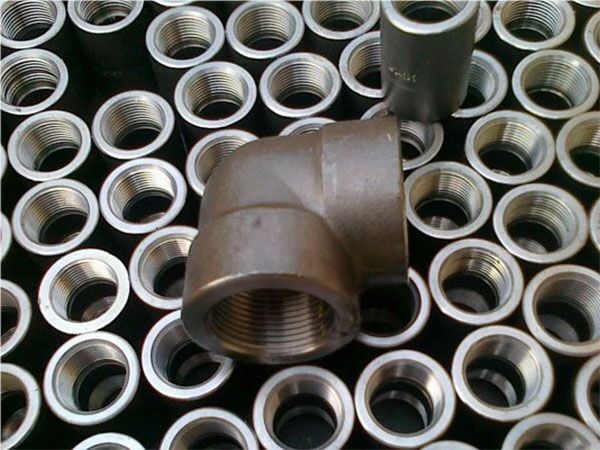Pipe fittings are usually components used to connect pipes or various parts of pipe systems. They play a crucial role in the pipeline system. All steel pipe fittings are pressure-bearing pipe fittings. According to different processing techniques, they are classified into four major categories, namely butt-welded pipe fittings (divided into those with and without welds), socket-welded and threaded pipe fittings, and flanged pipe fittings.
What is a carbon steel socket tube fitting?
Carbon steel socket welded pipe fittings are forged pipe connection components. Their structural feature is that concave "socket" holes are machined at one or both ends of the pipe fitting. After the pipe is inserted, the pipe and the pipe fitting are welded together by fillet welding. Unlike butt-weld pipe fittings, socket-weld pipe fittings are mainly used in pipeline systems with smaller diameters (generally NPS 2 "and below), and the material is usually
carbon steel (common grades such as ASTM A105, A350 LF2, A694, etc.).

The main production and inspection standards for carbon steel socket welded pipe fittings include: ASME B16.11 "Forged Pipe Fittings" of the United States (covering socket welded and threaded pipe fittings); The MSS (American Pipe Fittings Manufacturers Association) series standards such as SP-79 (socket reducer), SP-83 (socket welded joint/flange), SP-95 (welded plug/pipe clamp), etc. British BS 3799 (Steel threaded and socket welded pipe fittings for the petroleum industry). In terms of materials, ASTM standards (such as A105, A350 LF2, A694, etc.) are commonly used to stipulate the chemical composition and mechanical properties.
The common types of carbon steel socket welded pipe fittings include various forms of pipe fittings:
Socket welding elbows: There are two types, 45° and 90°, which are used to change the direction of the pipeline.
Socket welding tee: Used for tee branches, it can be in the form of equal diameter or different diameter.
Socket welding four-way (cross) : Connects four-way pipes to achieve multiple branches (equal diameter or unequal diameter).
Socket welding joints (sleeves) : They are divided into complete sets and half sets, and are used to connect two sections of pipelines. Among them, both ends of the complete set of joints are socket and spigot, while the half set only has socket and spigot at one end.
Pipe cap: It is used to seal the end of the pipeline, in a socket shape, and is welded to the pipe end by filling the corner.
Reducer (large and small heads) : Connects pipes of different diameters to achieve pipe diameter transition.
The manufacturing process of carbon steel socket welded pipe fittings mainly includes forging, heat treatment, mechanical processing and inspection.
Forging forming: After heating the carbon steel round billet to an appropriate temperature, it is forged into shape in a closed mold. Generally, closed die forging is adopted, and the required rough shape of the pipe fitting blank in the future.
Heat treatment: After forging, the billet usually undergoes normalizing or quenching + tempering and other heat treatments to obtain a uniform structure and meet the mechanical property requirements.
Machining: Turn the forged billet, drill the socket cavity and process the outer diameter of the pipe to ensure that the fit clearance between the socket and the pipe meets the specification requirements. Meanwhile, chamfering or threading (such as threaded joints), etc. need to be processed, and finally the finished pipe fittings that meet the dimensional tolerance are obtained.
Inspection and testing: Dimensional inspection, pressure test, hardness test and non-destructive testing (such as ultrasonic flaw detection, magnetic particle or penetrant testing) are carried out on the processed pipe fittings to ensure that the quality meets the standard requirements.
Common specifications and parameters
The common nominal size range of carbon steel socket welded pipe fittings is NPS 1/2 "to 4" (i.e., DN15 to DN100), and they are mainly used in small-diameter pipeline systems. The pressure grades (Class) usually include Class 3000, 6000, and 9000 (pound level), and some standard and custom products also cover Class 2000.
According to ASME B16.11, socket welded pipe fittings are marked with nominal diameter (NPS), and the dimensions match those of pipes of the same diameter. Both the connection dimensions and the nominal dimensions comply with the standard provisions. For example, MSS SP-97, etc. provide corresponding dimensions for the branch outlet (Olet). The commonly used material is carbon steel (such as ASTM A105/A350, etc.), and occasionally stainless steel or alloy steel is also used to manufacture pipe fittings that meet special working conditions.
Advantage
High strength and good pressure resistance: It has a high pressure-bearing capacity and excellent sealing performance.
Easy installation: No need to bevel at the pipe end. After the pipe fittings and pipes are inserted, they can be directly welded at the corner, allowing for quick assembly and high construction efficiency.
Lower cost: The processing and installation costs are lower than those of butt welding.
Application field
Petrochemical industry: High-pressure oil (gas) pipelines and small-diameter instrument pipelines in facilities such as oil refineries and chemical plants.
Natural gas: Socket weld pipe fittings are used in small-diameter high-pressure gas transmission pipelines in urban gas networks, gas source pipelines and gas filling stations and other equipment.
Power industry: Small-diameter pipelines such as boiler feed water, steam pipelines, and circulating cooling water systems in power plants.
Shipbuilding industry: high-pressure small-diameter pipes for ship power pipelines, cooling systems, etc.
Boiler system: High-pressure feed water and steam pipelines in thermal power plants or industrial boilers.
